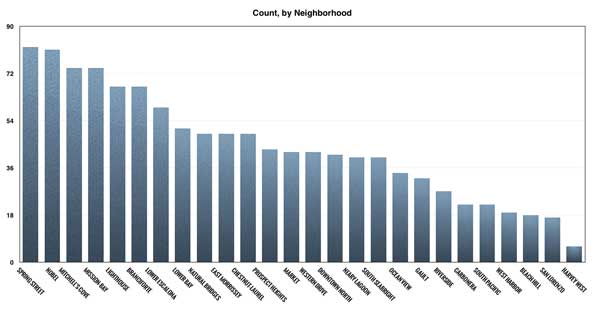In the morning on September 27th, Field Operations Manager Alison Lowenthal, engineer Colin Miller, and our new apprentices, Cameron Langston and Rafferty Lincoln, headed up in the truck to see if we could get to the mountaintop where fire had threatened. It was Cameron’s first day at work — what a first day. Ralph Silveira, one of our top field staff, drove out, too, but had to head home with a flat tire. Over 2,000 acres were now burning, but the fire had moved south of our site, so we were hoping to reach our equipment.

Trying to get to Cruzio’s gear, but not yet allowed up, September 27th
The mountain facility doesn’t have a permanent generator, so we have to bring our own when power is down. Usually we have enough battery power to last out any outage, but in this case the power could be down for many days, PG&E said. Over a dozen nearby utility poles had burnt or fallen or both.
Cruzio needed to get the generator running to recharge the batteries before they ran out of juice.
Emergency personnel stopped our team partway up the winding mountain road. “Not safe yet.” We know there are two entrances to the site — and our customers are depending on us — so the crew drove down the mountain, onto Highway 17, and tried going in the north entrance, opposite where the fire was burning. Chris Frost, our Director of Technology and Infrastructure, coordinated with Cal Fire to determine the safest way up the mountain.
They stopped at Tomita Hill, where they took this photo of Loma:

Loma Fire September 27th
The unpaved roads on that side are even more winding. Once again Field Ops were stopped by Cal Fire staff, who told them “But if you go back around the other entrance, maybe you can get in that way.” So they drove all the way back down to 17, and back up again to where they’d started. Then they waited at the road block for a few hours.

Cruzio’s Colin Miller (center, in white tee shirt) at the road block
Delay was pushing the limits of our equipment. Back at Cruzio, we were watching (on internet monitors) as the power supplies drained away.
Mark Hanford, our Chief Systems Engineer, was re-routing all the customers he could away from Loma Prieta. Networks have some amount of flexibility — that’s why every site is important, and redundancy is crucial — so Mark was reconfiguring the network to route around the emergency. In a short time, he had moved almost all our customers away from the problem.
Then we waited to see if the power would go down before our crew could get in.

One side of the mountain was burned to ash
At 5:30 pm, half an hour was left on the battery. Time ticked away. 15 minutes. 10. At 6 pm, Mark said “Okay. Power can go off any second now.” Our team was still waiting at the Cal Fire stop, waiting for entry. Capacity on the batteries went to zero.
But miraculously our power didn’t go out. The batteries kept running. They kept going past their expected charge. Mark stayed at the office, waiting for the power to go off so he could check on his emergency network routing. 7 pm. 8 pm. The batteries didn’t die. Our guys were waiting on the mountain. 8:30 pm.
Finally, the batteries were out at 8:50. They had run on “empty” for two and half hours!
Then, just after battery power went out, we got word: Cal Fire was escorting Cruzio’s team up the hill in a convoy of fire and water trucks, and onto our site. It was stop-and-go all the way up the mountain as the fire was hard to work around. Although diminished at that time, some flames were only feet away from the vehicles.
“We could hear the fire like a jet engine,” recounted Colin Miller, “You could see the embers flying into the trees [near] where the vehicles were.” It was clear, though, that the fire was moving away and our team made it up the mountain safely.
It only takes 5 minutes to power up the generator. Our crew had it going in no time. Then they took turns watching all night, and sleeping in shifts, to make sure everything ran smoothly.
Up there on the tower, above the smoke the air was clear. After a long day of braving the smoky air and fire, Field Ops took the opportunity to end the night with some stargazing. Alison Lowenthal summarized the day: “It’s intense, but it’s actually a lot of fun. I love being up on Loma.”
Continue Reading: The Aftermath
















